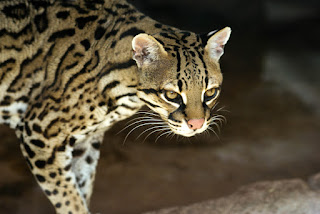
The ocelot is a medium-sized cat found in Central and South America (all countries except Chile) and Texas. Ocelots can be found in a variety of habitats, including rainforests, semi-deserts, mountain forests, grasslands, and mangroves. It is found at elevations of up to 12500 feet. The ocelot was nearly hunted to extinction in the second half of the twentieth century. Although the ocelot is protected, its population is slowly increasing due to habitat loss. The ocelot is an endangered species.
Interesting facts about Ocelots:
The ocelot is twice the size of a domestic cat. It can grow to be 28 to 35 inches long and weigh between 24 and 35 pounds. Males are physically larger than females. The length of a tail is half the size of the body.
Ocelots have beautiful fur, which is why they are hunted. The fur is typically tawny, yellow, or brown-grayish in color, with black rosettes and stripes.
Ocelot teeth are pointed and used for biting, while blade-like teeth are used for tearing food. Because it lacks teeth for chewing, it swallows large chunks of food.
Ocelots have a raspy tongue that successfully extracts every last scrap of meat from bones.
Carnivores, ocelots (meat-eaters). They eat rodents, monkeys, tortoises, armadillos, rabbits, birds, lizards, fish, and snakes, among other things.
Ocelots have excellent eyesight (adapted to night vision) and hearing, which they use to detect prey.
Ocelots are nocturnal (active only at night). They spend the day resting in hollow trees, on branches, or in dense vegetation.
Ocelots are easy prey for larger cats (such as jaguars and pumas), birds of prey (eagles), and large snakes due to their smaller size (anaconda).
Ocelots, unlike other cat species, are not afraid of water. They are fantastic swimmers.
Ocelots are solitary and territorial creatures. Males typically live on 30 square meters of land. Females occupy a two-fold smaller territory.
Ocelots are active 12 hours a day. During that time, the ocelot may travel up to 7 miles in search of food.
Males and females only congregate during the mating season. Ocelots can reproduce all year long in tropical areas. Ocelots mate at the end of the summer in temperate climates.
When ocelots are ready to mate, they let out a loud yowl. Every other year, females have one litter. The pregnancy lasts 85 days and results in 2 to 3 kittens.
Blind kittens are born. Their entire body is covered in thick, dark fur. After one month, they will open their eyes and begin to develop additional fur colors. At the age of one year, young ocelots are ready to begin their independent life.
The average ocelot lifespan is 10 to 13 years in the wild and up to 20 years in captivity.









